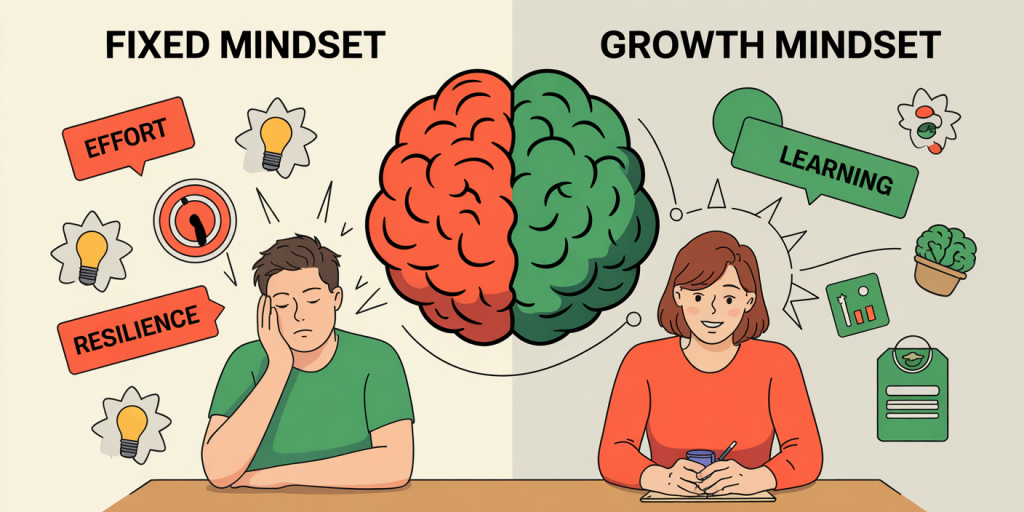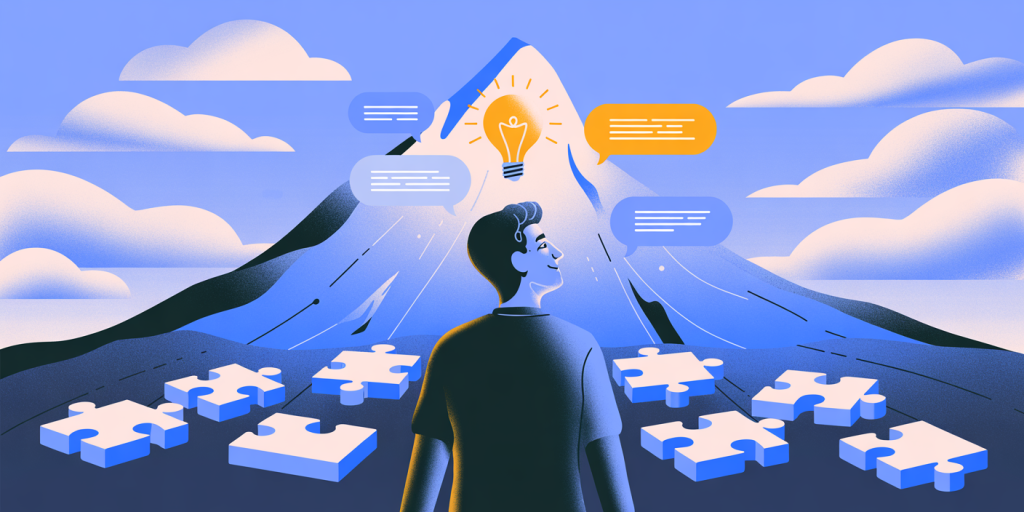Growth Mindset: How to Develop and Apply It to Your Daily Life
Anúncios
In today’s rapidly changing world, the ability to adapt, learn, and overcome challenges is crucial for personal and professional success. One of the key psychological frameworks that enable this is the concept of a growth mindset. Coined by psychologist Carol Dweck, a growth mindset revolves around the belief that intelligence, skills, and abilities can be developed through dedication and hard work, rather than being fixed traits. This empowering view contrasts with a fixed mindset, where individuals perceive their capabilities as static, thus limiting growth and innovation. Understanding how to cultivate a growth mindset and apply it in daily life can lead to increased resilience, motivation, and overall success.
Across educational systems, workplaces, and even in sports, evidence increasingly supports that adopting a growth mindset can contribute positively to outcomes. For instance, a study published in *Psychological Science* showed that students who were taught that their intelligence could grow over time improved their academic performance by up to 11 percentile points compared to peers without such training. This article explores practical strategies to develop and apply a growth mindset, supported by examples and comparisons, to help you foster continuous personal development.
Anúncios
Understanding Growth Mindset vs. Fixed Mindset
To fully harness the power of a growth mindset, it is important to first differentiate it clearly from a fixed mindset. A fixed mindset assumes that talents, intelligence, and abilities are innate and unchangeable. Individuals with this mindset tend to avoid challenges, give up easily, and see effort as pointless. Conversely, a growth mindset embraces challenges, persists in the face of setbacks, and views effort as a path to mastery.
Consider two employees at a technology company facing a complex coding problem. The one with a fixed mindset might say, “I’m just not good at programming,” and avoid further learning opportunities. The other, with a growth mindset, thinks, “This problem is difficult, but I can improve by practicing and seeking help.” The latter approach fosters innovation and continuous improvement, yielding better results over time.

Below is a comparative table to illustrate key differences:
| Aspect | Fixed Mindset | Growth Mindset |
|---|---|---|
| Belief about ability | Innate and static | Developable through effort |
| Approach to challenges | Avoid or give up | Embrace and persevere |
| View of effort | Seen as fruitless | Seen as essential for growth |
| Response to failure | Discouraged, may quit | Learn from mistakes, try again |
| Reaction to feedback | Defensive or ignore | Accept constructive criticism |
Such mindset orientation profoundly influences behavior, leading to different long-term outcomes in learning, career advancement, and personal well-being.
Strategies to Develop a Growth Mindset
Developing a growth mindset involves intentional effort and self-awareness. One foundational approach is to reframe the meaning of failure. Instead of viewing mistakes as signs of incompetence, treat them as valuable feedback that points you toward improvement. For example, Thomas Edison famously regarded his early unsuccessful attempts at inventing the light bulb as “10,000 ways that won’t work.” This mindset allowed him to persist until success was achieved.
Another effective strategy is to embrace challenges actively. Deliberately placing yourself in situations outside your comfort zone encourages learning and resilience. A practical example is learning a new language or skill despite initial discomfort. According to a 2022 report by the World Economic Forum, employees who regularly seek to upskill themselves demonstrate up to 30% higher adaptability and job performance.
Positive self-talk also plays a critical role. Research indicates that individuals who use encouraging internal dialogue tend to display more persistence and less anxiety. Instead of thinking, “I can’t do this,” replace the thought with, “I can learn how to do this with practice.” This shift builds confidence and fuels motivation.
Lastly, setting learning goals rather than just performance goals is a key practice. For instance, instead of targeting “getting an A on the test,” aim for “understanding the concepts behind the test.” This focus nurtures a love for learning over mere grade acquisition, supporting long-term growth.
Applying a Growth Mindset in Education and Career
In education, shifting to a growth mindset can revolutionize how students approach learning. Teachers play a pivotal role by praising effort, strategies, and progress rather than innate ability. For instance, a teacher who says, “You worked hard on this essay, and it shows great improvement” encourages students more than a comment like, “You’re so smart.” This approach helps students develop persistence and a robust approach toward challenges.

A real-world example comes from a New York City public school system that implemented growth mindset training for teachers and students. Over the course of a year, students showed improvement in math scores by an average of 8%, especially among those who previously struggled. These gains highlight how cultivating growth mindset practices in classrooms yields measurable benefits.
In professional environments, applying a growth mindset encourages continuous learning, innovation, and collaboration. Google’s famous “Project Aristotle” research found that psychological safety in teams — where members feel free to take risks and learn from mistakes — is critical to high performance. This culture aligns closely with growth mindset principles, boosting team creativity and productivity.
Managers can foster this mindset by encouraging experimentation and rewarding learning behaviors rather than just results. For instance, offering employees opportunities to learn new skills, providing constructive feedback, and recognizing effort can create an environment where growth thrives.
Growth Mindset and Personal Relationships
A growth mindset not only benefits academic and professional spheres but also improves personal relationships. Approaching relationships with the belief that communication skills, empathy, and emotional intelligence can improve over time encourages healthier interpersonal connections.
For example, couples who view conflicts as issues to work through rather than evidence of personality flaws exhibit stronger relationships. Research published in the *Journal of Social and Personal Relationships* shows couples with growth-oriented beliefs about change are more likely to stay together and improve communication.
Similarly, friendships benefit when individuals believe that misunderstandings and disagreements are opportunities for growth and deeper understanding. By focusing on constructive dialog and learning from mistakes, relationships become more resilient and satisfying over time.
Measuring Growth Mindset: Tools and Techniques
To track your development of a growth mindset, various measurement tools and techniques can be employed. The most common method is self-assessment surveys, such as the one developed by Carol Dweck and colleagues, which measure your beliefs about intelligence and abilities.
Additionally, journaling challenges and responses can reveal how you react to setbacks and whether your internal dialogue supports growth or fixed thinking. Keeping a learning diary that documents what you have struggled with and how you responded strengthens meta-cognition and mindset awareness.
Workplace assessments can include 360-degree feedback processes focusing on openness to change and the use of feedback. This broad evaluation helps individuals and leaders identify fixed mindset tendencies and target development areas.
Future Perspectives: The Growing Importance of Growth Mindset
Looking ahead, the significance of a growth mindset will likely increase as the pace of technological advancement and economic disruption accelerates. According to the McKinsey Global Institute, by 2030, up to 375 million workers worldwide may need to switch occupational categories and learn new skills due to automation and AI adoption. Cultivating a growth mindset will be vital for adaptability in this shifting labor landscape.
Educational institutions are increasingly integrating growth mindset principles into curricula to prepare students for uncertain futures. Similarly, corporations adopt mindset training as part of leadership development and talent management programs, realizing the correlation between mindset and innovation.
Moreover, with the rise of remote work and digital collaboration, resilience and self-directed learning — core aspects of a growth mindset — become ever more essential. Individuals who embrace lifelong learning and remain flexible will be better positioned to succeed across various fields.
Research will continue to evolve, exploring how mindset interacts with neuroplasticity and behavioral change. Emerging technologies, such as AI-driven personalized learning platforms, may further enhance the development of growth mindset assets by providing tailored feedback and challenges.
Organizations and individuals who prioritize growth mindset cultivation are expected to gain competitive advantages and experience greater long-term fulfillment.
In summary, developing a growth mindset involves understanding the difference between fixed and growth orientations, actively reframing challenges and failures, and incorporating strategies like positive self-talk and learning-focused goals. Applying these principles across education, career, and personal relationships leads to tangible benefits demonstrated by numerous studies and real-world examples. Looking forward, growth mindset adoption will remain a crucial skill for navigating an evolving and uncertain future, ensuring adaptability, wellbeing, and success.

